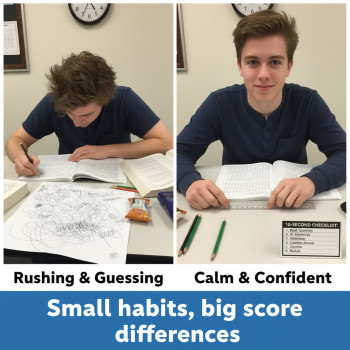Introduction: Why this matters — and why you can breathe
If you or your student are planning to apply to the University of Iowa, one of the first questions that pops up is: what are the SAT requirements? Between the shift to the Digital SAT, evolving test-optional policies, and the flood of advice online, it’s easy to feel overwhelmed. Take a deep breath. This is a practical, human guide — written for students and parents — that explains what the University of Iowa typically looks for, how the Digital SAT fits into your application, and how to plan a calm, strategic approach to testing and preparation.

At a glance: The University of Iowa and the Digital SAT
The University of Iowa, a large public research university, treats SAT scores as part of the admissions picture rather than the sole determinant. Many applicants submit scores; many successful applicants do not. A few quick facts to keep in mind as you start planning:
- The University of Iowa typically considers SAT scores if you submit them — it is not necessarily a strict requirement for every applicant.
- When scores are submitted, they fall into a range that represents most enrolled students — that range is a useful target, not an absolute cutoff.
- The Digital SAT replaces the older paper SAT. The test format, timing, and practice options have changed, so preparation should reflect the digital experience.
What “considered if submitted” means
Some universities have fully test-optional policies, while others are test-optional for certain terms or applicant types. The phrasing “considered if submitted” means the University of Iowa will review SAT results if you include them — but not submitting scores won’t automatically disqualify you. Admissions officers will place scores alongside GPA, coursework, essays, recommendations, extracurriculars, and other contextual factors. In short: if your strengths shine elsewhere, you may choose to apply without scores; if your SAT score strengthens your application, it can help.
Understanding the SAT score range and target numbers
When thinking about the SAT, applicants often ask: what score do I need? Rather than a single magic number, it helps to aim at a range that reflects the academic profile of admitted students. For practical planning, consider the following typical score bands and what they mean for your strategy.
| Category | Composite (Total) Score | What it usually implies |
|---|---|---|
| Competitive for many admitted students | 1140–1310 (approximate) | On par with the middle applicants; can strengthen applications for many majors. |
| Above-average/Strong | 1310+ | Helps distinguish academically strong applicants, especially for competitive programs. |
| Below the typical range | Below 1140 | Consider additional context (GPA, rigor, essays), or plan to retake the Digital SAT after targeted prep. |
Keep in mind these ranges describe where many enrolled students fall. A lower score does not automatically rule you out, and a higher score is not a guarantee. Admissions is holistic.
Digital SAT specifics: how it’s different and why it matters
The new Digital SAT brings changes you should know about because they affect how you prepare and perform:
- Shorter overall testing time, but adaptive sections that change based on performance.
- Comfort with digital tools — navigating passages, line references, on-screen calculations — becomes important.
- Practice on the actual digital interface reduces test-day anxiety and builds speed.
Because the test format is digital, practice should replicate that experience. Using official digital practice tests (and timed simulations) is far more valuable than drilling on paper-only practice materials.
Should you take the Digital SAT for the University of Iowa?
If you plan to submit scores, yes — take the Digital SAT. That’s the current testing format, and university admissions will expect the scores to come from that format. If you’re undecided about submitting scores, take a practice test first (digital) and see whether your performance would strengthen your application.
When to submit scores — timing your Digital SATs
Timing matters. Here’s a clear, parent-friendly timeline you can follow, whether you’re a sophomore exploring options or a senior applying this cycle:
- Junior year spring: Take a practice Digital SAT to set a baseline. Begin a prep rhythm (weekly practice, targeted skill work).
- Summer before senior year: Intensive prep block (4–8 weeks) with full-length digital practice tests every 1–2 weeks.
- Senior year early fall: Take the Digital SAT if you plan to submit scores. If needed, plan one retake before application deadlines or scholarship deadlines.
- If your preferred University of Iowa application deadline is early (e.g., scholarships or priority applications), aim to have scores ready 3–4 weeks prior to those deadlines to allow score reporting and buffer time.
How many times should you take the SAT?
Most students take the SAT 1–3 times. A first test gives a baseline; a second gives a performance boost after targeted study; a third is for fine-tuning. Balance practice aggressiveness with mental health — overscheduling late in senior year can add stress. Use official digital practice diagnostics to identify your two or three most meaningful improvement levers.
Superscoring, score choice, and University of Iowa policy
Policies like superscoring and score choice can influence whether you submit multiple scores and how you present them:
- Score Choice is a College Board feature that lets you choose which test dates to send to colleges. Using it allows you to send only your best test date(s).
- Superscoring means a school may combine your best section scores from different test dates into a new composite. Colleges set their own superscore policies.
The key takeaway: verify the University of Iowa’s current approach to superscoring. If they superscore, submitting multiple test dates may be beneficial; if not, focus on your single best test date. In many cases where a university says scores are “considered if submitted,” admissions teams will use scores in whatever way best contextualizes your application — so use Score Choice strategically and submit scores that reflect your strengths.
How admissions officers view SAT scores in context
SAT scores are one part of a story. Admissions officers look for patterns and context. Here are the main ways your overall application complements or compensates for SAT performance:
- Academic rigor: A strong transcript with advanced courses strengthens an application even if SATs are average.
- Upward trends: Improving grades show momentum and often matter more than a single test score.
- Essays & recommendations: Clear, personal essays and strong counselor/teacher recommendations convey character and fit.
- Extracurricular impact: Sustained leadership, meaningful community work, or talents make an application memorable.
When test-optional makes sense for you
Choose test-optional if your SAT scores are far below your transcript’s signal, or if you face inequities that affected your testing opportunities (e.g., limited access to prep resources). Choose to submit if your SAT score bolsters your candidacy or helps with scholarships. The decision is personal and strategic — talk it through with your counselor or a trusted tutor.
Practical prep plan: what to do in 12 weeks
Here’s a straightforward 12-week Digital SAT plan geared to busy students. This plan focuses on high-leverage improvements: reading strategy, math fundamentals, and digital test practice.
- Weeks 1–2: Diagnostic digital practice test + review. Identify top three weakness areas.
- Weeks 3–6: Skill blocks — two weeks on math fundamentals (algebra and data), two weeks on reading and writing strategy.
- Weeks 7–9: Focused practice on question types (data analysis, evidence-based reading, command of evidence). Use timed digital sections.
- Weeks 10–11: Full-length digital practice tests every 5–7 days, with in-depth review after each.
- Week 12: Light review, rest, and test logistics (device check, test-day routine, sleep schedule).
This plan is flexible. For students who can only prepare part-time, compress the plan into longer daily sessions or extend to 16 weeks for gentler pacing.
How targeted tutoring can accelerate progress
Targeted, personalized tutoring is one of the fastest ways to convert practice into score gains. A tutor can diagnose patterns that practice tests miss—timing habits, common careless errors, or inefficient strategies for digital navigation. Services like Sparkl offer 1-on-1 guidance, tailored study plans, expert tutors, and AI-driven insights that help students focus on the few levers that produce the biggest score improvements. If you’re balancing school, activities, and family obligations, a personalized plan keeps progress steady and efficient.
Test-day tips for the Digital SAT
Test day feels big — and a few practical routines will keep you calm and sharp:
- Do a device check well before test day. Make sure the testing app is updated and that you’ve completed any setup steps.
- Simulate test-day conditions during practice: timed sections, minimal breaks, and the same digital interface.
- Bring all required identification and admission materials as specified by the testing authority.
- Plan for sleep and nutrition the night before: a rested brain outperforms marathon cramming.
- During the test, mark and move on. Use the adaptive nature of the test to manage time strategically — don’t get stuck on a single problem.

Putting scores into your application strategy
Once you have scores, think strategically about application timing and presentation:
- If your score is within or above the University of Iowa’s typical range, submitting may reinforce academic fit.
- If your score is below the range but your transcript, essays, and activities are strong, you might opt to apply without scores.
- Consider submission for scholarship opportunities — some scholarships still heavily weigh standardized test results.
| Situation | Suggested Action |
|---|---|
| Score above 1310 (your target) | Submit; highlight in application if relevant to merit scholarships. |
| Score 1140–1310 | Submit — it aligns with many admitted students and complements GPA. |
| Score below 1140 | Consider retaking after targeted prep or apply test-optional if other parts of application are strong. |
Scholarships and the SAT: what to know
Scholarship policies vary. Some merit-based scholarships favor higher standardized test scores, while others prioritize GPA, leadership, or specific achievements. If you’re aiming for merit dollars at the University of Iowa, submitting a strong SAT score can be helpful. Before deciding, check each scholarship’s criteria and deadlines — and make sure any score you submit reaches the university early enough for scholarship review.
Common FAQs: quick answers parents and students ask
Q: Is the University of Iowa test-optional?
A: The University of Iowa considers SAT scores if submitted. Whether to submit is a choice you can make strategically based on how your score complements the rest of your application.
Q: Does the University of Iowa superscore the SAT?
A: Superscoring policies can change. If you have multiple test dates, check current admissions guidance or contact the admissions office to confirm how they treat multiple scores. As a rule of thumb, if a school superscores, sending multiple dates can work in your favor.
Q: How important is a high SAT for competitive majors?
A: Some majors — especially those with selective admission to limited-enrollment programs — can be more competitive. A stronger SAT may help in competitive scenarios, but program-specific requirements and academic preparation often carry equal or greater weight.
Real-world examples: students who made decisions
Example 1 — Emma, aspiring bio major: Emma had a 3.9 GPA and strong science coursework but a single SAT score below the typical range. She did two things: completed a 10-week targeted prep plan and retook the Digital SAT, raising her score by 70 points. She submitted those improved scores, which helped her feel confident when applying to health-science-oriented programs.
Example 2 — Jamal, arts-focused applicant: Jamal’s strengths were a portfolio, strong teacher recommendations, and a standout personal essay. His SAT was lower than the range. Jamal and his counselor chose test-optional, and he was admitted with scholarships tied to his portfolio and leadership in the arts.
How parents can help — practical support, not pressure
Parents play a crucial role in steady encouragement and logistics. Here are practical ways to support your student without dialing up stress:
- Help create a calm test schedule; encourage consistent practice rather than last-minute cramming.
- Provide a quiet study space and healthy routines (sleep, meals) around test days.
- Consider budgeting for a tutor or targeted program if your student needs structure and expert feedback. Personalized help like Sparkl’s 1-on-1 tutoring and tailored study plans can make prep efficient and confidence-building.
- When discussing scores, emphasize the whole application — character, essays, activities, and fit matter just as much.
Checklist before you submit your University of Iowa application
- Decide whether to submit SAT scores — weigh score strength vs. other application strengths.
- Confirm application and scholarship deadlines and ensure scores will arrive in time.
- If submitting, use Score Choice (if helpful) to send the best test dates.
- Have a final essay review and one set of eyes on your application materials to check consistency and narrative.
- Keep copies of all submissions and testing receipts for your records.
Final words: calm strategy beats panic
Applying to the University of Iowa is an exciting step. The Digital SAT is one piece of a bigger story about who your student is and what they’ll bring to campus. Whether you submit scores or apply test-optional, the best strategy is intentional: know your current standing, set realistic practice goals, prepare on the digital platform the test uses, and make decisions that align with your student’s strengths.
Personalized help can make a real difference. For many families, a steady tutor or a tailored program that identifies high-impact improvements — like Sparkl’s 1-on-1 guidance, tailored study plans, expert tutors, and AI-driven insights — turns scattered prep into measurable progress. If you’re uncertain, a conversation with a trusted counselor or tutor can help illuminate the most efficient path forward.
Quick next steps
- Take a full-length digital practice test to establish your baseline.
- Make a 12-week plan that includes diagnostic testing, targeted skill blocks, and timed practice.
- Decide whether you’ll aim to submit scores, and schedule the Digital SAT so scores arrive before application deadlines.
- Reach out for help if you need it — targeted, personalized tutoring can be time- and cost-efficient if it gets you closer to your goal.
Good luck — and remember, this process is a marathon, not a sprint. With a calm plan, the right practice, and solid support, the University of Iowa application can be a meaningful step toward the next great chapter.














No Comments
Leave a comment Cancel